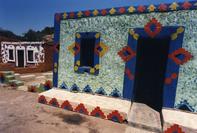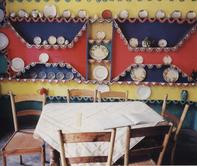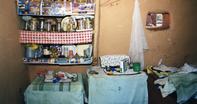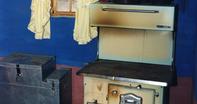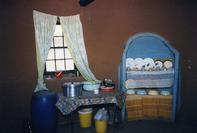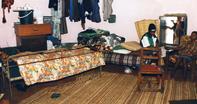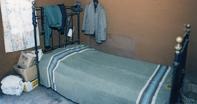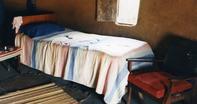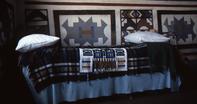
Decorating the Interior of Homesteads
The use of mural details is more commonly found on the exterior of buildings, but women also take considerable pride in decorating the interior of their homes. Colourful details may be found in communal spaces like kitchens, but some women decorate private spaces like bedrooms as well.
Emulating the practice among early white settlers of filling sideboards with plates and other display items, many women build display shelves from materials like clay and wood salvaged from packing cases. Inventive use of colour adds to the artistry of shelving of this kind.
Built-in structures are now often decorated with the pages of advertisements. In the past, when colourful images such as these were comparatively rare, women usually cut delicate doily-like motifs from black and white newsprint.
Lacking access to other sources of fuel, many rural communities rely on the use of wood-burning stoves. In winter, the heat generated by these stoves is always welcome. In summer, doorways and windows are left wide open to help lower the temperature when cooking.
Very few rural communities have access to running water. Instead they rely on collecting water from communal taps and boreholes, even rivers. Stored in large plastic containers, this water is used sparingly for cooking, cleaning dishes, washing laundry, and bathing in buckets filled from containers heated on wood-burning stoves.
In the past, rural people seldom had access to cupboards. Clothing was stored in boxes, and jackets were hung from nails in the walls and rafters.
Old brass beds and cardboard boxes also afford knobs and crossbars for hats and other personal effects. Other valued items like walking and hunting sticks are stored in the comparatively inaccessible corners.
While iron and brass beds, old wooden kists and enamel jugs and basins continue to adorn some rural homes, articles like these have gradually been bought up by antique dealers. Because of the revived interest in 19th century furniture by some urban communities, many rural homes now contain household items bought from commercial outlets in towns and other small centres throughout South Africa. Some of these distributors cater to the widespread market for articles like large wall clocks.
Ndebele women sometimes decorate bedroom areas with intensely coloured murals similar to those found on the exterior walls of their homes. Other decorative accents are afforded by carefully arranged blankets and beadwork items.
By
Professor Sandra Klopper